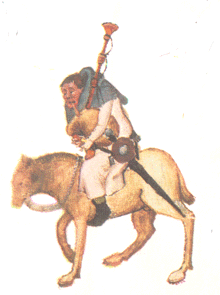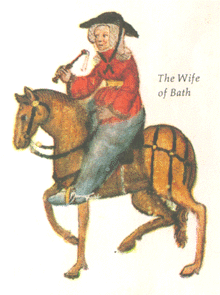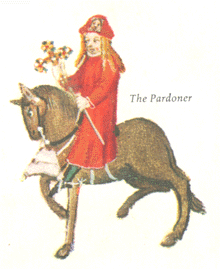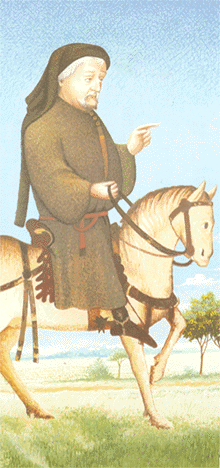
The
Miller's Tale
| Stories such as
this were rather common in the inns of Chaucer's time. The tale has its bawdy moments, but
it is funny to see the stupidity of the jealous carpenter fall for Nicholas' preposterous
flood rather than the ends for which the trick was devised. The carpenter is
cuckolded and has a broken arm because of his extreme jealousy. Nicholas has a severely
burned rear end. Absalon has been mistreated in another way. Destiny or poetic justice
played an important role in the tale. Vision and astrology play a role, too. The contrast
between the noble Knight and the burly Miller is made prominent by the type of story each
chose to relate. The type of story the Miller tells is still popular today. Any time a
very old man marries a young girl, there will be jealousy and the wife might take on a
love. |
 |
Study Questions on Chaucer II
On "The Miller's Tale":
6. What kind of imagery does Chaucer use to
describe Alison? Is she a well-rounded character or a type? Why?
7. What are we supposed to think of the final "justice" in
the end of "The Miller's Tale"?
8. What do you think about the Miller and the Miller's Tale?
9. Is there any relationship between the Miller's appearance and the
content of his tale?
10. Who is the winner in "The Miller's Tale"?
Justify your answer.
The
Wife of Bath's Prologue
And Tales
 |
THE WIFE OF BATH'S
PROLOGUE
|
- To justify her five marriages and to suggest
that the thing women most desire is to complete control over their husbands. 1. A defense
of her marriage 2. A confession of her techniques and a plea for certain reform for women.
She uses two basic arguments: 1. If women remained virgins, there would be no one left to
give birth to more virgins, 2. the sex organs are to be used for pleasure as well as
function. The W of Bath can quote scripture to prove her points. Her prologue refutes
the popular theory that women should be submissive, especially in matters of sex. And her
argument is against the authorities of the church and state and that she is a woman who
prefers experience to scholarly arguments.
|
 |
- Dame Alison:
-- amorous, nagging
-- fun, practical, nice to her husbands--generous
--Her love of life is also praiseworthy
--Despite the loss of youth and beauty, she faces her future
not only with a woman's ability to endure and enjoy what she cannot reshape, but also with
a zest for life.
-- frank: she tells the truth better than the pardoner.
-- she uses psychology to manage her husbands
-- she enjoys her past, accept the fact; a good nature
¡@
 |
The Wife
of Bath's tale |
¡@
- This tale is an exemplum, a tale told to prove a point. And the
reader should remember that the narrator is an old hag telling a story about an old hag
who gained sovereignty over her husband.
- In Chaucer's time, the lit. was filled with
the favorite theme of vilifying the frailty of woman. Chaucer's tale is not a moral
diatribe for or against woman. He creates a woman in the person of the W. of B who both
exemplifies all that has been charged against women but openly glories in the possession
of these qualities. Chaucer does not make it clear whether he sympathizes with the
Wife's opinion of marriage and celibacy, but it is obvious that he did not agree with the
prevailing notions of his time about celibacy. Usually a second marriage is
considered sinful. A revolutionary document!
Also there was considerable praise for perpetual virginity. But if
everyone practices virginity, who is to beget more virgins? The Wife of Bath pleads for
the emancipation of women in the Middle Ages.
- The story matches the storyteller--consistency
- How does it fit the Wife of Bath (Why does
she tell this kind of tale)?
1. she tells the story to prove that everything will turn out
well if the wife rules, if the wives have mastery over their husbands.
2. She is attacking the establishment (the way things were,
the church, the knighthood, the unholy friar). She is making fun of the unholy men, like
the friar: "Women may now go safely where they like: They'll find no other satyr
there but he: And he'll do nothing worse than take their honour."
3. She wants to prove that women are not amorous as men
thought at that time. The wife's revenge: women at that time were thought evil,
amorous.
- The knight's ordeal/test (in old stories
heroes solves riddles): to solve the riddle-- what women most desire.
His second ordeal: to choose between two--a beautiful but
unfaithful, or a ugly, old but faithful wife. He passes
the test (by placing himself in his wife's governance and let his wife choose for him) and
is rewarded: he gets a beautiful, young and good wife, and a
happy life.
- The knight is very rude to his old
wife at first--a knight should not behave like this. He should be grateful that this old woman saves his life. She teaches him a lesson
(leads the knight's initiation) which he should have learned
before he becomes a knight: Poverty is not guilt; one should respect old age. It's noble deeds that make the nobleman; it is not wealth or rank
makes a knight a knight.
- Chaucer took his own idea about the knight,
ill-behaved, ill-mannered (unlike other knight stories) The
value of woman's sovereignty.
- The story is suited to the Wife's own
character psychologically and dramatically, for she, like the old woman, had wedded a young man--though unlike the old woman, she couldn't
restore her former youth and beauty!
Study Questions on Chaucer II
On "Wife of Bath's Prologue and Tale":
11. According to the anti-feministic
theologians in the medieval church, what are the characteristics of women?
12. What metaphor does Wife of Bath use to describe the situation
when man and woman are put together?
13. Why does Chaucer have such a long detailed prologue for the Wife
of Bath?
14. Give a character sketch of the Wife of Bath.
15. In Wife of Bath's Tale, what is the point of telling us at the
beginning of the story about the supernatural creatures and their disappearance later?
16. What do you think about Chaucer's arrangement of the change of
the old wife's appearance and the happy ending?
17. What is special about the Wife of Bath's appearance and
personality? Is there a connection between her personality and the story?
18. How does Chaucer use humor in the tales of the Miller and the
Wife of Bath? Is there any difference in how he uses it in the two?
The
Pardoner's Prologue and Tale
 |
The PARDONER'S PROLOGUE |
The prologue starts out with a
confession--because he is with strangers and will not see them again The Pardoner is also
an exhibitionist (in words): a clever hypocrite exploits Christian principles in
order to rich himself.
"The love of money is the root of all evil"--the center of
his preach/tale--used most effectively in order to frighten
his hearers into a generosity that will fulfill his own rapacity (cupidity)/greed.
Exempla (exemplum): stories that illustrate concretely the
sermon's point; give example to illustrate
Consistency is in the general prologue and in the
introduction to the pardoner and the tale. ¡@ |
 |
 |
THE PARDONER'S TALE |
- The tale is about the destructiveness of avarice.
- Time: the bubonic plague; Black Death
- Lechery, drunkenness, greed, gluttony (drunk,
eating), gambling, perjury--there are also what the pardoner is doing--He is laughing at
his own weakness for he is doing the same thing himself.
- The climax of the story moves very
fast (only a few lines): The story of the young men who seek Death only to find him in a
treasure that had made them forget him is a masterpiece of irony.
- The pardoner's candid confession has
concealed the fact that he is a eunuch, but his secret is revealed in the epilogue by the Host's coarse response when the Pardoner tries to
collect money from the pilgrims--His verbal facility by which
he maintains his superiority fails him.
- Ironical: 1. The pardoner is very
good at speaking, but in the end of the story he is too angry to speak, to refute the
Host. 2. After his tale, he tries to trick them yet fails.
- Why does he trick them since he should know
they are intelligent?
1. So highly developed is his sense of irony that it enables
him to feel superior to other people.
2. He has been drinking too much.
3. It's a habit to get payment.
4. He over-estimates his cleverness; over-confident and
under-estimates the Host.
5. As exhibitionist, once he starts, he can't stop; He is
going to do it again.
- The epilogue: the Host's revenge--point out the
pardoner's physical weakness: not a complete man, a eunuch!
- It is interesting to see the interaction among the
pilgrims.
Study Questions on Chaucer II
On "Pardoner's Prologue and Tale"
19. What are the three biblical examples that
the Pardoner uses to illustrate "The luxur is in Win and dronkenesse"
(l.196)?
20. What do you think of the Pardoner's tale? Is the tale
consistent to the story teller's character?
Relevant
Links
 Canterbury Tales: It is offered in Middle
and Modern English , with illustrations.
Canterbury Tales: It is offered in Middle
and Modern English , with illustrations.
 Canterbury Tales Project:
In Sheffield, Oxford and Brigham, people transcribe all manuscripts from photographs into
computer readable form.
Canterbury Tales Project:
In Sheffield, Oxford and Brigham, people transcribe all manuscripts from photographs into
computer readable form.
 Chaucer's Canterbury Tales:
annotated version
Chaucer's Canterbury Tales:
annotated version
 Geoffrey Chaucer Page:
John Dryden (1631-1700)-Dryden was an admirer and translator of Chaucer. Included
are three translations from Canterbury Tales.
Geoffrey Chaucer Page:
John Dryden (1631-1700)-Dryden was an admirer and translator of Chaucer. Included
are three translations from Canterbury Tales.
 Labyrinth Library:
Middle English texts including works of Chaucer.
Labyrinth Library:
Middle English texts including works of Chaucer.
¡@
[Back to Medieval Literature]
¡@






![]() Canterbury Tales: It is offered in Middle
and Modern English , with illustrations.
Canterbury Tales: It is offered in Middle
and Modern English , with illustrations.![]() Canterbury Tales Project:
In Sheffield, Oxford and Brigham, people transcribe all manuscripts from photographs into
computer readable form.
Canterbury Tales Project:
In Sheffield, Oxford and Brigham, people transcribe all manuscripts from photographs into
computer readable form.![]() Chaucer's Canterbury Tales:
annotated version
Chaucer's Canterbury Tales:
annotated version![]() Geoffrey Chaucer Page:
John Dryden (1631-1700)-Dryden was an admirer and translator of Chaucer. Included
are three translations from Canterbury Tales.
Geoffrey Chaucer Page:
John Dryden (1631-1700)-Dryden was an admirer and translator of Chaucer. Included
are three translations from Canterbury Tales.![]() Labyrinth Library:
Middle English texts including works of Chaucer.
Labyrinth Library:
Middle English texts including works of Chaucer.